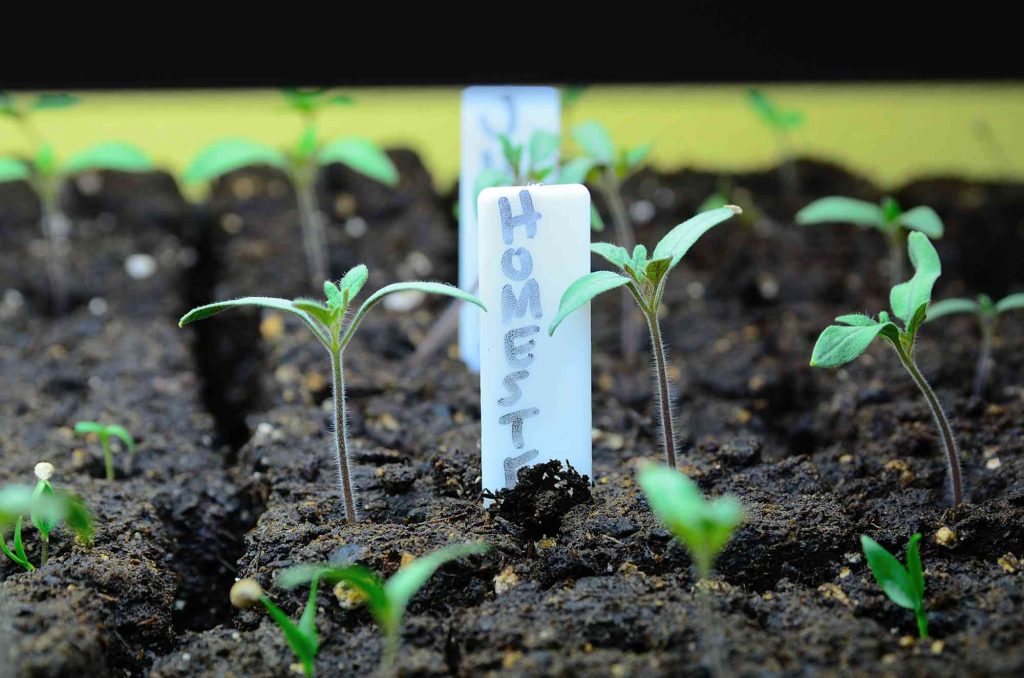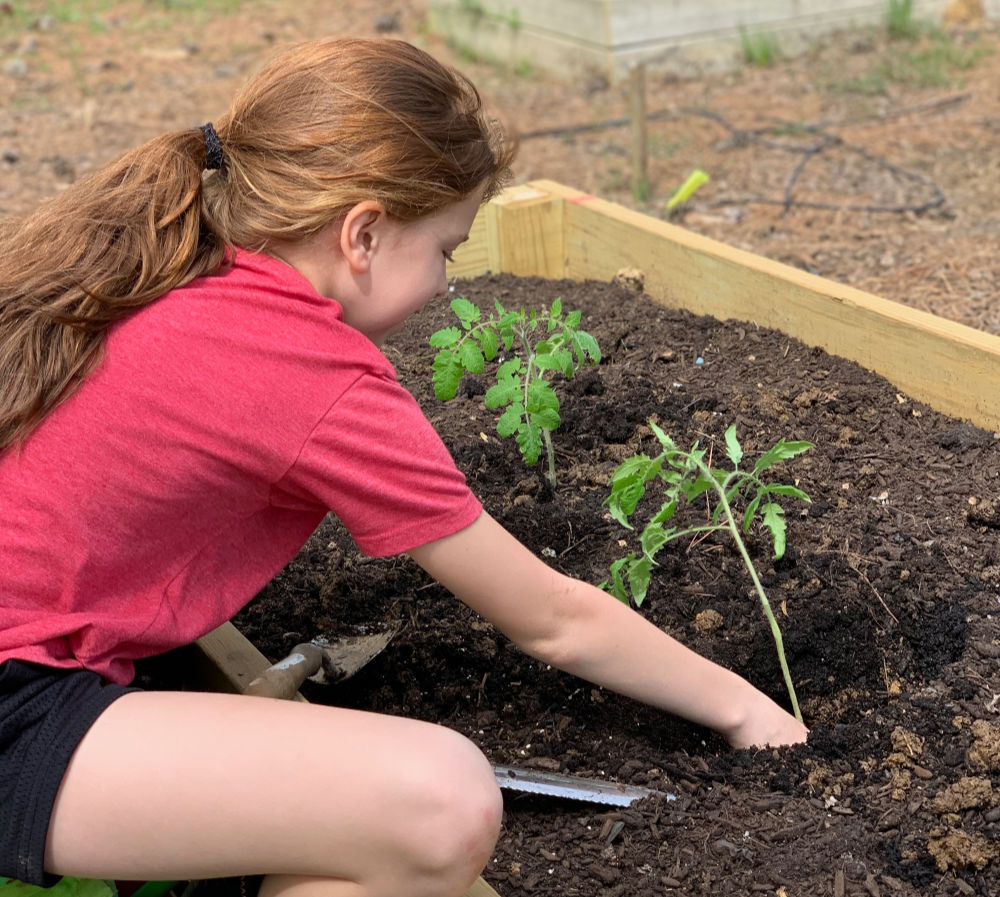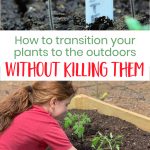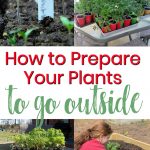Hardening Off Plants – Transitioning to the Outdoor Garden
After you’ve started your seeds, how do you transition them to the outdoor garden? Also known as hardening off plants, this is a critical step to get your seedlings ready to go outside. In this post, I’ll share what you need to know to successfully transition your seedlings to the garden.
*links below contain affiliate links
Starting your Seeds
Before you can think about hardening off your seedlings, you need ensure you’re starting off with healthy seedlings to begin with. Ideally, you have started them off with a good grow light. Healthy seedlings are also spaced appropriately, only one strong seedling per cell. When you start your seeds well, you set yourself up for better hardening off and transplanting.

Potting Up
Not all seedlings will need this, but some seedlings will grow out of their small container before they are ready for the ground. I use a plastic cup that holds about two cups of dirt. I primarily do this with my tomatoes and peppers and sometimes other crops that outgrow their containers before it’s time to get them outside.
Hardening Off Plants
When you have a seedling that has been growing in a controlled indoor environment, you can’t suddenly put that seedling outside in the ground. You want to slowly prepare that plant for the outdoors.
Why You Should Harden Off Plants
When you start seeds indoors with a grow light or even in a window, the light is not the same as the direct sunlight it will experience outdoors. Your plant needs to adjust to full sunlight. It also needs to be acclimated to the wind. A plant that hasn’t been in the wind is not strong enough to withstand a gusty day. Even if you have a fan blowing on your seedlings inside (which I recommend), it is not the same as the wind and your plants need to grow stronger slowly. Temperature swings from night to day are another reason to prepare your plants.
My Hardening Off Process
Each gardener hardens off plants his or her own way, but this is how I get my seedlings ready to thrive outside.
I start 1-2 weeks ahead of my outdoor planting time. On the first day, I put my plants outside in a shady spot for about an hour. The next day I’ll increase the time to two hours and they may get a little more sun. Every day, they will get progressively more sun and time outside.

Early in the process, I pay attention to the outdoor temperature; I don’t want the temperature to change too much at the beginning of the hardening off process. For example, if my indoor temperature is 70 degrees, I like to choose a time of day when the outdoor temperatures hover between 65 and 75 if possible.
As they’re in the sun in these containers, I also pay close attention and keep them well watered. Plants exposed to sun and wind dry out quicker than those in your controlled indoor environment.
Further along in the hardening off process, after I’ve added hours each day and the plants have grown acclimated to the outdoors most of the day, then I start to think about nighttime temperatures. I won’t leave them outside in containers when it is near frost temperatures, but they do need to prepare for temperature swings.
For an almost hardened-off tomato plant, for example, I’ll only leave them outside when nighttime temperatures are in the 50s. For peppers, I wait until the 60s.
When to Transplant
After the hardening off process is complete, start watching the weather for opportunities to transplant those seedlings into the garden.
You want to help your young plants have as smooth a transition as possible. Think about the temperatures outside, including the nighttime temperatures, and avoid planting when you expect any extreme temperature shifts.
Related: When to Plant What

You may want to transplant on a cloudy day, though it’s not always possible. I often transplant my crops later in the day so they miss the direct heat of the early afternoon. If rain isn’t in the forecast for the next day, make sure you water them well after transplant.
There are several things to think about when starting seeds and hardening off plants to transplant them into the garden. Do you have any hardening off tips you’d add to my process?
Do you get overwhelmed with garden planning?

Subscribe here for my best tips to plan your garden in just 7 days -- all for FREE.
Plus, I'll send you my "In the Garden E-mail" on Fridays, periodic updates on garden resources relevant to you, and you'll receive access to my entire bank of free garden downloads!
You are also agreeing to our privacy policy.




I’m using jiffy pot peat cups that can go directly in the ground or bed. This is my first time EVER attempting to grow anything and I’ve spent some $$ getting raised beds created. Your seedlings here are so much bigger than where mine are at the moment. I was planning to plant this weekend. Are yours at the optimum size for planting? If so I’d need to get mine bigger but I don’t know if they’ll grow that big if they’re in the jiffy pots….
Mine in this post were pretty large and it’s not necessary for your plants to be this size. I recommend making sure the plants have a few sets of “true leaves” on them before planting out. Also, I would recommend peeling off the outside peat layer from those pots when you plant them; I’ve never used them personally, but I’ve heard gardeners say the outside doesn’t break down as quickly as you’d expect them to. If it doesn’t, that could restrict root growth.
I planted some tomato plants in those Jiffy peat pots because I ran out of plastic pots and had about 20. Those tomato plants are so stunted growth wise, against the ones that I potted up to nursery pots, that I don’t even think I will plant them; they’ll probably end up as compost.
You might be surprised how tomatoes will rebound given some good soil and nutrition!
While hardening your plants do you still give them grow light like before?
( These plants germinated and grown with the help of 10 hours of indoor lights)
Yes, when I bring them back in, they are under grow lights like before until the grow lights shut off from 10 pm – 6 am daily.
Thank you for posting this, so far this year I have had quite the success in upbringing my seedlings but this gives me confidence that I won’t just kill them before they can even get into the dirt during the hardening process.
It’s always seemed pretty daunting and information a bit choppy from other resources but it seems like I am on track for a nice harvest at the end of the growing season!
All the best~
Thanks, Matt! Best of luck to you!
Great tips for preventing those “leggy” seedlings! We follow a very similar process and have had good success with starting our own plants, which definitely keeps the cost of the garden down and allows us to use our own seeds from last year.